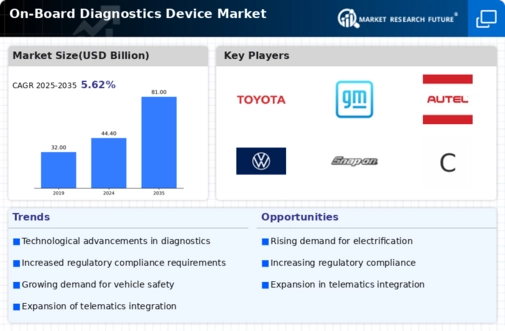Market Growth Charts
Rising Consumer Awareness
Rising consumer awareness regarding vehicle maintenance and performance is driving the Global On-Board Diagnostics Device Market Industry. Consumers are increasingly seeking vehicles equipped with advanced diagnostic systems that provide insights into vehicle health and performance metrics. This trend is further fueled by the proliferation of digital platforms that educate consumers about the benefits of OBD systems. As awareness grows, manufacturers are compelled to incorporate sophisticated diagnostic tools into their vehicles, thereby expanding the market. The anticipated growth in market value to 81.0 USD Billion by 2035 reflects this shift in consumer expectations.
Stringent Emission Regulations
Stringent emission regulations across various regions are significantly influencing the Global On-Board Diagnostics Device Market Industry. Governments worldwide are implementing tighter standards to reduce vehicular emissions, necessitating the adoption of advanced OBD systems. For instance, the European Union's Euro 6 standards compel manufacturers to equip vehicles with enhanced diagnostic capabilities. This regulatory environment is expected to propel the market towards an estimated value of 81.0 USD Billion by 2035. Consequently, automotive manufacturers are investing in OBD technologies to ensure compliance and avoid penalties, thereby driving market growth.
Increasing Vehicle Electrification
The ongoing trend towards vehicle electrification is a pivotal driver for the Global On-Board Diagnostics Device Market Industry. As electric vehicles (EVs) gain traction, the demand for advanced diagnostic systems that monitor battery performance and electric drive systems increases. This shift is evidenced by the projected market value of 44.4 USD Billion in 2024, as manufacturers seek to ensure compliance with stringent emissions regulations. Furthermore, the integration of sophisticated diagnostic tools is essential for maintaining vehicle efficiency and safety, thereby enhancing consumer confidence in EV technology.
Growth of the Automotive Aftermarket
The growth of the automotive aftermarket is a crucial driver for the Global On-Board Diagnostics Device Market Industry. As vehicles age, the demand for aftermarket services, including diagnostics and repairs, increases. This trend is particularly relevant as more consumers opt for vehicle maintenance solutions that utilize advanced OBD systems. The aftermarket segment is expected to benefit from the projected market growth, with an estimated value of 44.4 USD Billion in 2024. This growth is indicative of a broader trend where vehicle owners prioritize the longevity and performance of their vehicles through enhanced diagnostic capabilities.
Technological Advancements in Diagnostics
Technological advancements in diagnostic tools are reshaping the Global On-Board Diagnostics Device Market Industry. Innovations such as wireless communication, cloud computing, and artificial intelligence are enhancing the capabilities of OBD systems. These technologies enable real-time data analysis and remote diagnostics, which improve vehicle maintenance and reduce downtime. As a result, the market is projected to grow at a CAGR of 5.62% from 2025 to 2035. The integration of these advanced features not only enhances vehicle performance but also aligns with the increasing consumer demand for smart automotive solutions.























